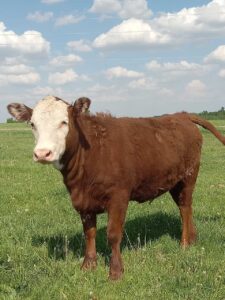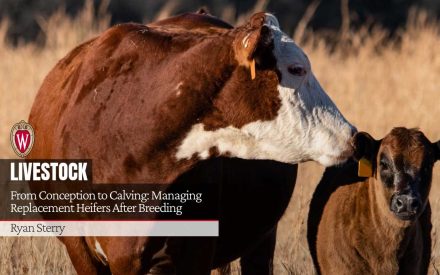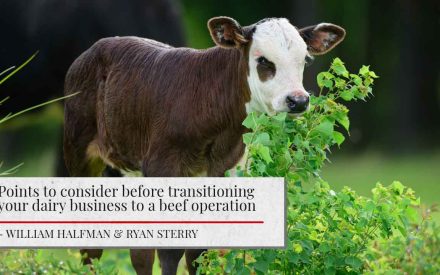English | en Español
Table of Contents

Introduction
To maintain its size, a beef herd’s annual replacement rate typically equals the number of cows that exit annually due to death, marketing, or culling. A typical replacement rate of 15% has been suggested. So, for the average Wisconsin cow-calf herd with 25 cows, four replacements per year are needed. Producers need to decide if purchasing replacements or breeding their heifers is best for their operation.
Puberty at 12 months of age

Heifers may only become pregnant after puberty is reached. Puberty is dependent on three things: age, weight, and breed composition. Pre-weaning, weaning, and post-weaning nutritional management is key to reaching puberty at 12 months of age. The heifer must continue to gain weight every day, not stall out, nor get sick, during the weaning process, and continue to grow with a consistent average daily gain. She must be fed to reach 55-65% of the cow’s herd’s mature weight, without getting fat, when she is 12 months old.
Monitor heifers for estrus activity (physically watch, use tailhead paint or patches) once you have decided upon the heifer’s breeding season. Make sure heifers have adequate space and good footing to allow them to safely express estrus. Estrus synchronization for AI or timed AI works well with heifers, especially with those who have shown one or two heat cycles before the start of the synchronization protocol.
Deliver before the herd’s calving season
Optimally she should calve 3-6 weeks before the herd calves. For example, if the herd’s calving season is June 1 to July 15, then heifers should begin calving May 1. With an approximate 283-day gestation length, targeting a heifer calving date of May 1 means a prior breeding date of July 23. So, to fit the June cow calving season, begin breeding the heifers in mid-July, and the cows in mid-August. Use veterinary diagnostics to confirm pregnancy beginning 32-42 days after the start of the cow’s breeding season to select your bred heifer replacements from those who conceived early; sell late conceiving heifers as a better fit for someone else’s herd.
Do you have the facility/ability to breed during different time frames? To fit your management, it may be better to sell open heifers or breed heifers with the cows during one breeding season to produce heifers for another’s calving season. For example, if your management may only handle one breeding season in late August, then advertise bred heifers (confirmed pregnant) for summer or fall-calving herds; your bred heifer should calve in June, ahead of the herd whose calving season begins in July.
When breeding heifers during the cow’s breeding season, you will need to manage and nutritionally support that first calf heifer after she calves (potentially separate from the herd) so that she is ready to breed during your herd’s one-time breeding season. Without managing her growth, she will likely conceive late in the breeding season; over time your herd’s calving season will continue to be pushed back to later in the year.
Calve as a two-year-old weighing at 85% of the mature equivalency and BCS 5-6
Pregnant heifers should be weighed, body conditioned scored, and their ration adjusted to support growth. After calving, they may need to be fed separately from the cow herd to allow ration adjustments for continued growth.
Records and measurements (scale) are ‘must haves’ for raising herd replacements. Multi-generational breeding, calving, and weaning dates are needed for selecting heifers to breed and for determining the target breeding date and weight. Birth, weaning and mature cow weights are needed for making herd-specific reproductive management decisions. Without accurate data, you are left using industry standards and estimates, both of which often lead to sub-optimal herd-specific results.
Read the entire fact sheet
Author

Sandy Stuttgen
County Livestock Educator – Sandy is an associate professor with UW Division of Extension and serves as the agriculture educator for Taylor County. Her focus areas include cattle well-being and quality assurance programming, farm financial risk management, and farm succession.


 From Conception to Calving: Managing Replacement Heifers After Breeding
From Conception to Calving: Managing Replacement Heifers After Breeding Edad y peso objetivo al criar vaquillas para carne
Edad y peso objetivo al criar vaquillas para carne 🎧 LISTEN: Points to consider before transitioning your dairy business to a beef operation
🎧 LISTEN: Points to consider before transitioning your dairy business to a beef operation Using Genomics as a Decision-Making Tool for Commercial Replacement Heifers
Using Genomics as a Decision-Making Tool for Commercial Replacement Heifers


